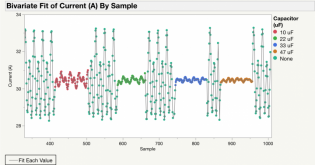schroederjd
Solar Enthusiast
- Joined
- Nov 12, 2020
- Messages
- 175
Clearly I need to read (and understand) these spec sheets better. In this case of my voltage divider, is the 'filter resistor' R1? If that's the case, current consumption would be insane. Op-amp it is. I'll need to do some homework on this, including reviewing the parts you and Cal are using, to figure out what I need and how to use it. I won't ask you for a recommendation (although I would accept one...), but any links to documentation that might steer me in the right direction would be much appreciated.Yes but you can't ignore the 100 k resistor, the error you can get is higher than what you calculated. Also the 6 M figure is a typical value, worst case can be worse. And the leakage current is random within the range specified, it's not like it's a nice fixed 6 M resistor, so you can't really calibrate it.
Often you'll find the recommended maximum value for input resistors in the datasheet section talking about the anti-aliasing filter (but also apply to any other resistance like your voltage divider for example). Here it says "Limit the filter resistor values to below 1 kΩ." and I would highly recommend to follow that, but that means your voltage divider will have a very low impedance so a high current consumption. That's why you want to use an op-amp so you can have a high impedance divider
Good point. I was thinking of it as a absolute max, but the possible upper end of my pack voltage range does put me above Vdd (58.4v / 11 = 5.31V). Will definitely plan to target voltages below 4.5 in the final design.Also, the Vdd + 0.3 V figure is from the absolute maximum ratings table, never design using those values (read the warning just under the table for more info). The recommended operating conditions table says Vdd is the max for input voltage (and personally I would avoid going near Vdd anyways since you can expect having most of the non-linearities here).
When defining the range of the ADS1115, I was mainly focused on the current sensor, which has a range of 2.5 +/- 2.5V. To avoid having to divide the current sensor voltage (or limit its range), I was planning to use the full range of the ADS. I realize that I'll probably sacrifice a bit of linearity at the very top end of the sensor's limit, but I really don't expect to be pulling 150A very often. I may end up moving to a current sensor with a 3.3v operating range anyway, which would allow me to go with the +/- 4.096V range without dividing.Note: the datasheet says "If a VDD supply voltage greater than 4 V is used, the ±6.144V full-scale range allows input voltages to extend up to the supply. Although in this case (or whenever the supply voltage is less than the full-scale range; for example, VDD = 3.3 V and full-scale range = ±4.096V), a full-scale ADC output code cannot be obtained. For example, with VDD = 3.3 V and FSR = ±4.096V, only signals up to VIN = ±3.3 V can be measured. The code range that represents voltages |VIN| > 3.3 V is not used in this case." so if you power the ADC with 5 V the recommended configuration would be to use the 4.096 V reference and scale your input signal to be just under that.
Yes, that's right. I'm only getting 15-bit resolution the way I'm using it. That seems to be the case even for my differential measurements (i'm using the Vref from the current sensor for differential measurements).Note²: the datasheet also says "Single-ended configurations use only one-half of the full-scale input voltage range." so in SE configuration it's like you have a 15 bits ADC at best. It's not a big deal but you can't ignore it in your accuracy and resolution calculations.
Thanks so much for all the info BidulOhm. I'd be nowhere on this without the info guys like you have generously shared on this forum.
-jon





